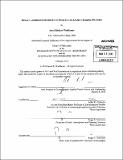Molecular Biogeochemistry of modern and ancient marine microbes
Author(s)
Waldbauer, Jacob Richard
DownloadFull printable version (47.05Mb)
Other Contributors
Woods Hole Oceanographic Institution.
Advisor
Sallie W. Chisholm and Roger E. Summons.
Terms of use
Metadata
Show full item recordAbstract
Biological activity has shaped the surface of the earth in numerous ways, but life's most pervasive and persistent global impact has been the secular oxidation of the surface environment. Through primary production - the biochemical reduction of carbon dioxide to synthesize biomass - large amounts of oxidants such as molecular oxygen, sulfate and ferric iron have accumulated in the ocean, atmosphere and crust, fundamentally altering the chemical environment of the earth's surface. This thesis addresses aspects of the role of marine microorganisms in driving this process. In the first section of the thesis, biomarkers (hydrocarbon molecular fossils) are used to investigate the early history of microbial diversity and biogeochemistry. Molecular fossils from the Transvaal Supergroup, South Africa, document the presence in the oceans of a diverse microbiota, including eukaryotes, as well as oxygenic photosynthesis and aerobic biochemistry, by ca. 2.7Ga. Experimental study of the oxygen requirements of steroid biosynthesis suggests that sterane biomarkers in late Archean rocks are consistent with the persistence of microaerobic surface ocean environments long before the initial oxygenation of the atmosphere. In the second part, using Prochlorococcus (a marine cyanobacterium that is the most abundant primary producer on earth today) as a model system, we explored how microbes use the limited nutrient resources available in the marine environment to make the protein catalysts that enable primary production. Quantification of the Prochlorococcus proteome over the diel cell-division cycle reveals that protein abundances are distinct from transcript-level dynamics, and that small temporal shifts in enzyme levels can redirect metabolic fluxes. This thesis illustrates how molecular techniques can contribute to a systems-level understanding of biogeochemical processes, which will aid in reconstructing the past of, and predicting future change in, earth surface environment
Description
Thesis (Ph.D.)--Joint Program in Oceanography/Applied Ocean Science and Engineering (Massachusetts Institute of Technology, Dept. of Earth, Atmospheric, and Planetary Sciences; and the Woods Hole Oceanographic Institution), 2010. Cataloged from PDF version of thesis. Includes bibliographical references.
Date issued
2010Department
Joint Program in Oceanography/Applied Ocean Science and Engineering; Woods Hole Oceanographic Institution; Massachusetts Institute of Technology. Department of Earth, Atmospheric, and Planetary SciencesPublisher
Massachusetts Institute of Technology
Keywords
Joint Program in Oceanography/Applied Ocean Science and Engineering., Earth, Atmospheric, and Planetary Sciences., Woods Hole Oceanographic Institution.